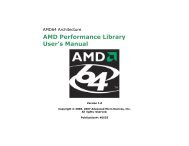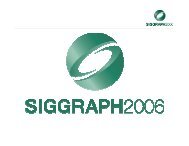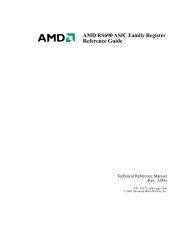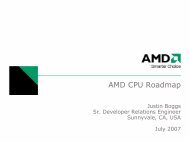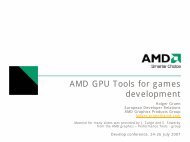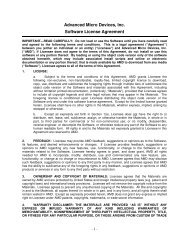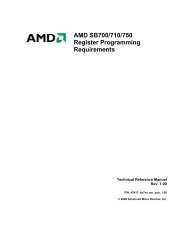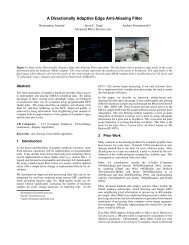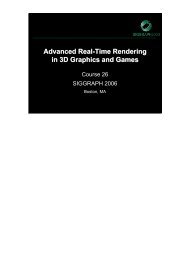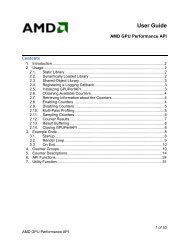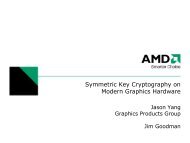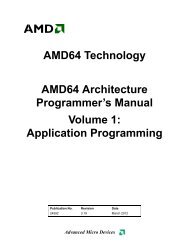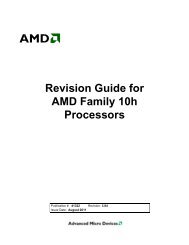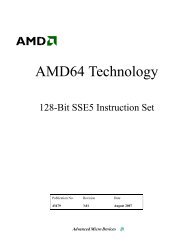Slides - AMD Developer Central
Slides - AMD Developer Central
Slides - AMD Developer Central
Create successful ePaper yourself
Turn your PDF publications into a flip-book with our unique Google optimized e-Paper software.
Hello! My name is Natalya Tatarchuk, and today I’ll share with you our approaches for<br />
using GPU tessellation to render crowds of animated, detailed characters. This<br />
presentation builds upon our methods for GPU scene management for crowd<br />
rendering.<br />
2
One of the goals of our work has been to increase visual fidelity for rendering the<br />
characters. The result needs to match the artistic vision for the character – and,<br />
ideally, surpass it!<br />
We sought a technique that allows detailed internal and external silhouettes, but that<br />
works coherently and seamlessly with MSAA. The use of GPU tessellation in<br />
conjunction with displacement mapping allows us to get closer to this goal.<br />
3
Here is an example of a character designed to meet the needs of current games – it’s<br />
a low resolution mesh (around 5K triangles) for our Frog Goblin character, the Froblin.<br />
Notice the coarse silhouettes and lack of detail in the highlighted regions.<br />
4
Using tessellation on characters (and other parts of the environment) allows superior<br />
detail and high quality animation. You can instantly see the difference in the amount<br />
of fine scale detail such as the bumps on his skin in this shot.<br />
5
Here is a close up so that you can see the real difference between a conventional<br />
rendering without tessellation<br />
6
And with using GPU tessellation and displacement mapping. We definitely start<br />
getting a much better feel for the warts and wrinkles on this character’s skin.<br />
7
We wanted to be able to increase visual fidelity in variety of complex scenarios, not<br />
only in cases of rendering a single character. In our dynamic interactive environment,<br />
from the Froblins demo, we have a large world, full of thousands of characters,<br />
simulated directly on GPU.<br />
8
As such, we had to be able to support a range of viewpoints with the same visual<br />
fidelity. Here you see a far away (bird’s eye) shot with thousands of characters.<br />
9
However, when we would get close to any of these characters, we wanted to see a<br />
great deal of details on them – without losing significant performance or having to<br />
swap in new meshes.<br />
Our solution takes advantage of GPU tessellation available on a number of recent<br />
commodity GPUs.<br />
10
We designed an API for a GPU tessellation pipeline taking advantage of hardware<br />
fixed-function tessellator unit available on recent consumer GPUs. We start by<br />
rendering a low resolution mesh (also referred to as control cage).<br />
The tessellator unit generates parametric coordinates on the tessellated surface (the<br />
uvs) and topology connectivity for subdivided input primitives amplifying the original<br />
data up to 411 times.<br />
The generated vertex data is directly consumed by the vertex shader invoked for<br />
each new vertex.<br />
The super-primitive vertex IDs and barycentric coordinates are used to evaluate the<br />
new surface position.<br />
The amount of amplification can be controlled either by a per draw call tessellation<br />
level or by dynamically computing tessellation factors per-primitive edge for the input<br />
mesh.<br />
11
With Direct3D 10 API and beyond, we can combine tessellation with several<br />
additional features, such as geometry shaders, stream out, and instancing. We can<br />
also use these features for an animation and transformation pass for the lowresolution<br />
control cage.<br />
12
There several important advantages to using GPU tessellation. We can design one set<br />
of assets to use with and without GPU tessellation (with an addition of a<br />
displacement map). The latter can be used on systems without GPU tessellation<br />
to do complex per-pixel lighting effects.<br />
Fine geometric detail are captured by the displacement map. Animation data is only<br />
stored for the control cage (the low resolution mesh).<br />
13
Thus we can think of hardware tessellation as an effective form of geometry<br />
compression. We can see this in the table where we compare the footprint for a<br />
GPU tessellation-ready model (a little over 10 MB) with a comparable high<br />
resolution model for the full character mesh (450 MB). We see that for a modest<br />
increase in memory footprint, we dramatically increase the total polygonal count<br />
for the rendered mesh when using GPU tessellation.<br />
14
We use interpolative planar subdivision with displacement to efficiently render our<br />
highly detailed characters. The benefits of this approach (as opposed to higher order<br />
surface evaluation) is extremely fast computation of new surface positions.<br />
Additionally, the interpolation happens on triangular domain, which allows us to use<br />
the same low-resolution mesh assets as traditional rendering for the control cage.<br />
15
We can use tessellation to control how fine we are going to subdivide this character’s<br />
mesh.<br />
We specify tessellation level, controlling the amount of amplification, per draw-call.<br />
We can use the information about character location on the screen or other factors<br />
to control the desired amount of details.<br />
Per-draw call tessellation level specification works well for rendering individual<br />
characters, such as this contemplative Froblin here.<br />
16
However, this approach doesn’t necessarily scale well for dynamically simulated<br />
scenarios, as in this picture (and our environment).<br />
If we use this strategy, the amount of draw-calls can increase drastically in crowded<br />
scenarios, as the number of tessellated characters we wish to render increases.<br />
17
In many scenarios, we may not know the exact number of tessellated characters in a<br />
given view. This is particularly important in cases where the simulation happens on<br />
the GPU, and changes interactively, with no a priori control.<br />
18
We need to be able to render high quality detailed characters, even if we suddenly<br />
enter extremely crowded areas, without bringing the application down to a crawl.<br />
19
To address this challenge, we utilize DirectX 10.1 features for level of detail<br />
management to render our froblins as an army of instanced characters.<br />
20
We can use this method along with stream out buffers and geometry shaders for GPU<br />
scene management and texture arrays to create visually interesting and varied crowd<br />
of characters. Here in the example, we note that the creatures tinted with red are<br />
rendered with GPU tessellation, the green froblins are rendered with conventional<br />
rendering and the blue froblins use simplified geometry.<br />
21
The tessellation level is calculated as follows:<br />
Here, T i is the tessellation level to be used for character instances in the first detail<br />
level, N is the number of character instances in the first detail level, and T max is the<br />
maximum tessellation level to use for a single character. This scheme effectively<br />
bounds the number of triangles created by the tessellator, and ensures that the<br />
primitive count will never increase by more than the cost of M fully tessellated<br />
characters. If there are more than M such characters in the view frustum, this<br />
scheme will divide the tessellated triangles evenly among them. While this can lead<br />
to slight visual popping as the size of the crowd changes dramatically from one frame<br />
to the next, in a lively scene with numerous animated characters this popping is very<br />
hard to perceive.<br />
22
When we render animated characters with subdivision, we need to perform<br />
animation calculations on the control mesh (the superprimitives), and then<br />
interpolate between the animated superprimitive vertices. A brute force approach of<br />
transforming and animating the superprimitive vertices in the evaluation shader<br />
wastes performance and bandwidth due to redundant computations – all newly<br />
generated tessellated vertices would perform the same computations as on the<br />
original vertices. Because hardware tessellation can generate millions of additional<br />
triangles, it is essential to minimize the amount of per-vertex computations posttessellation,<br />
and to perform animation calculations only once per control vertex.<br />
23
We improve performance with a multi-pass approach for rendering out animated<br />
characters. We compute control cage pre-pass, where we can compute all relevant<br />
computations for the original low resolution mesh, such as animation and vertex<br />
transformations. This method is general and takes advantage of Direct3D® 10 stream<br />
out functionality.<br />
In the first pass we perform input mesh animation and transformations; rendering<br />
the base mesh vertices as instanced sets of point primitives, skinning them, and<br />
streaming out the results. Since we are performing this computation on the coarse<br />
input mesh, we can afford higher quality skinning as well as significantly reduce<br />
geometry transform cost.<br />
1/9/2009 3:44 PM<br />
24
In the next pass, we tessellate the already animated and transformed mesh, using the<br />
original input primitive vertices’ vertex ID and instance ID to retrieve and interpolate<br />
the transformed vertices from the stream out buffer, and apply displacement<br />
mapping.<br />
1/9/2009 3:44 PM<br />
25
Note that using this multi-pass method for control cage rendering is beneficial not<br />
only for rendering tessellated characters, but for any rendering pipeline where we<br />
wish to reuse results of expensive vertex operations multiple times. For example, we<br />
can use the results of the first pass for our animated and transformed characters for<br />
rendering into shadow maps and cube maps for reflections.<br />
1/9/2009 3:44 PM<br />
26
Although it is helpful to stream and re-use the animation calculations, this alone is<br />
not fully effective.<br />
The vertex data will be streamed at full precision, and the evaluation shader must still<br />
pay a large cost in memory bandwidth and fetch instructions to retrieve it.<br />
We augmented our control cage multi-pass method with vertex compression and<br />
decompression.<br />
1/9/2009 3:44 PM<br />
27
This modification helps reduce the amount of memory being streamed out per<br />
character, as well as reduce vertex fetch and vertex cache reuse for the evaluation<br />
shader.<br />
28
We use a compression scheme to pack the transformed vertices into a compact 128bit<br />
format, allowing the tessellation pass to load a full set of vertex data using only<br />
one vertex fetch.<br />
29
We compress vertex positions by expressing them as fixed-point values which are<br />
used to interpolate the corners of a sufficiently large bounding box that is local to<br />
each character.<br />
30
We can compress the tangent frame by converting the basis vectors to spherical<br />
coordinates and quantizing them. Spherical coordinates are well suited to<br />
compressing unit length vectors, since every compressed value in the spherical<br />
domain corresponds to a unique unit-length vector.<br />
31
Texture coordinates are compressed by converting the uv coordinates into a pair of<br />
fixed-point values, using whatever bits are left. To ensure acceptable precision, this<br />
requires that the uv coordinates in the model to the 0-1 range, with no explicit tiling<br />
of textures by the artist.<br />
32
Here we have performance analysis for different methods of rendering our character,<br />
starting from conventional (no GPU tessellation rendering).<br />
33
We notice that brute force conversion to GPU tessellation reduces performance (as<br />
compared to rendering the input low resolution mesh) to about 50% while<br />
dramatically increasing the overall quality of character rendering (as seen in this<br />
image).<br />
34
A straight-forward conversion of GPU tessellation to multi-pass rendering doesn’t<br />
offer any performance improvement, as we notice here.<br />
35
However, although the compression scheme requires additional ALU cycles for both<br />
compression and decompression, this is more than compensated for by the reduction<br />
in memory bandwidth and fetch operations in the evaluation shader.<br />
The multi-pass GPU tessellation approach with shader-based vertex compression<br />
provides 54% performance increase over the single pass GPU tessellation<br />
performance.<br />
36
Furthermore, we notice that this method is 70% as fast as low-resolution mesh<br />
rendering, while rendering over 411 times MORE polygons for our high-quality<br />
character!<br />
37
In this table, we compare performance of using dynamic method for computing<br />
tessellation amount based on crowd density versus a statically specified tessellation<br />
level. We notice that our method provides 41% increase in overall frame<br />
performance, which is impressive considering a huge number of other elements<br />
present in this frame (performing GPU simulation, rendering cascade shadows, postprocessing,<br />
just to name a few).<br />
38
Next, we also wanted to mention a couple of production challenges that we’ve<br />
encountered while working on our algorithms. One particular aspect of rendering<br />
characters with displacement mapping is dealing with maps that contain texture uv<br />
borders as they frequently introduce texture uv seams.<br />
40
UV borders are rarely one-to-one in parameterization. Unless neighboring borders are<br />
laid out with the same orientations and lengths, displacing with these maps will<br />
introduce geometry cracks along the seams.<br />
Here we highlighted the specific edges along the texture seam (in green). Note that<br />
the adjacent edges for this seam do not have uniform parameterization.<br />
41
Example of a visible crack generated due to inconsistent values across the edges of<br />
displacement map for this character. This crack is generated along the seam that we<br />
highlighted in green on the previous slide.<br />
Note that the images’ contrast and brightness have been manipulated for higher<br />
contrast.<br />
1/9/2009 3:44 PM<br />
42
Typically, with brute force displacement map generation, different floating point<br />
values are created across edges. Even if we had textured our character with tiled<br />
textures (however impractical of a concept), while this seamless parameterization<br />
alleviates bilinear artifacts, we still have to worry about floating point precision<br />
mismatch along the seams.<br />
43
To solve this problem, we post-process our displacement maps by correcting all the<br />
texture uv borders as follows.<br />
44
First, we identify the border triangle edges (i.e. edges that contain vertices with more<br />
than one set of texture coordinates).<br />
45
Then, for each border edge, we compute the texel locations for the vertices; fetch,<br />
average, and update the texels for matching vertices.<br />
46
As long as all these border vertices map to unique texel locations, we can ensure a<br />
crack-free displacement mapping using nearest neighbor texture filtering.<br />
47
To improve uv seams for linear texture filtering and/or hardware tessellation, for each<br />
border edge, we sample the edge with equidistant points. Then, for each sampled<br />
point, we fetch, average and update the texels for matching points. Because the<br />
points might not map one-to-one, we repeat the above process several times to<br />
enhance the result. At the end, we dilate the uv borders.<br />
48
This technique is attractive because it is fast, simple to implement and it generates<br />
good results.<br />
49
Furthermore, this method does not require additional computations at run-time,<br />
which is very important when evaluating surface positions for subdivision surface,<br />
which frequently may contain millions of triangles at render time!. This functionality<br />
is integrated into the freely available GPUMeshMapper tool.<br />
50
To conclude, our methods provide a set of techniques allowing dramatic<br />
improvement in visual quality for our rendered characters, letting technology match<br />
the creative vision of the artists. Using GPU tessellation with displacement mapping<br />
and the multi-pass technique with vertex compression in the shaders allows excellent<br />
performance with tremendous jump in visual fidelity. Additionally, we also developed<br />
a method to increase the quality of generated displacement maps to use with our<br />
algorithms.<br />
51
I’d like to thank some folks who contributed to the techniques we just described and<br />
who also worked on the Froblins demo.<br />
52
If you are interested in further information, here are some helpful links.<br />
53



